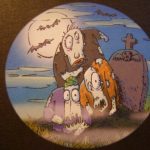
The Maya, Polynesia, and the Sweet Potato
I’ve always been fascinated with etymology and the development of languages, so much so that I enrolled in a college class entitled, “History of the English Language.” Don’t laugh. I’m a word nerd. Case in point: I recently returned from two weeks in Central America and became mesmerized by the Mayan glyphs. These glyphs are the only Mesoamerican writing system that has been extensively deciphered, and they offer intriguing insights into Mayan culture.
While in Guatemala, I heard the story of another obsession of mine—the sweet potato, which originated in Central and South America as far back as 8000 years ago. In contrast, the earliest record of the sweet potato in central Polynesia is around 700 A.D., and in New Zealand around 1300 A.D. The first European encounter with the root vegetable came with Columbus’ crew in 1492 A.D. So how did the Polynesians get the sweet potato? Until recently, scientists dismissed the notion of contact between the Americas and Polynesia prior to the arrival of the Spaniards. Few believed these ancient peoples had the sophistication to build ocean-going vessels.
One scientist who rebelled against his contemporaries was Norwegian ethnographer, Thor Heyerdahl. In 1947, he built a primitive raft, the Kon-Tiki, and sailed 4300 miles from South America to French Polynesia to prove the ancient peoples were capable of Pacific crossings. He believed it was the people of the Americas who settled Polynesia in Pre-Columbian times. He based this belief on the evidence of the sweet potato migration as well as similarities between many words used throughout Mesoamerica and Polynesia. For instance, the Quecha people in the Andes of South America use the word kumar for the sweet potato, similar to the Maori (New Zealand) word kumara and similar cognates throughout Polynesia.
As new discoveries are made, scientists are opening their minds to the possibilities of Polynesian migrations to the Americas but are slow to accept migrations from the Americas. Another intriguing story I heard on my trip adds fuel to Thor Heyerdahl’s hypothesis. Matthew Cowley, a missionary from the early 1900s, spent years among the Maori in New Zealand learning their language and translating records. He received an odd response when he asked an old Maori man where he came from. Surprisingly, the man told him that his people had originally come from “the place where the sweet potato grows wild.” Matthew Cowley knew there was only one place in the world where the sweet potato grows wild—Mesoamerica.
When evidence of advanced civilizations throughout Ancient America is combined with the unexplained migrations of language and the sweet potato across the Pacific, I’m convinced that these people were capable of oceanic crossings. What do you think?
References:
www.phys.org, “Sweet potato DNA indicates early Polynesians traveled to South America,” Jan. 22, 2013.
www.npr.org, “How the Sweet Potato Crossed the Pacific Way Before the Europeans Did,” Jan. 23, 2013.
www.history.com, Thor Heyerdahl’s Kon-Tiki Voyage, Oct.6, 2014.
Cowley, “Matthew Cowley Speaks,” (Salt Lake City: Deseret Book Co., 1954), p. 114.




Who knew? Good stuff
Thanks, David!
I was a Peace Corps volunteer in Tonga (Polynesia). I learned the language during the two years I spent there. Afterward, I ended up staying a few weeks in a pair of Mopan Mayan villages in southern Belize. While there I learned Mopan. My notebook indicates I had about 400 words of vocabulary. I started noticing words that were almost or exactly the same sound, *and* the same or very similar meaning. This curious coincidence did not happen between my Spanish and Tongan except for words that were clearly borrowed, such as telephono and telefoni. Of my 400 Mopan words, there were about seven that I placed on a special list as being “coincidences”. Example: Tz’i tz’i means small in Mopan. Si’i si’i means small in Tongan. They are pronounced almost identically.
My last day in the Mopan village, the mother of the family I stayed with delivered me a meal unlike any I have seen in central America. It is a cooked mixture of leaves and meat. When she set it down in front of me I immediately recognized it – as Tongan. In surprise, I called it by its Tonga name, “Lu”. The mother, used to my speaking bits of her language, was not at all surprised that I apparently knew its Mopan name, “Liu”. In Tonga, the dish is specifically made with the leaf of the Taro plant. I asked the father of the family to show me the plant the Mayans used. It had the unmistakable large heart shaped leaves of the Taro plant, although seemed to be of a bushier variety than grows in Tonga today.
So, yes, there was contact between the Mopan Maya (currently on the east coast of central America, and the Polynesians). By the way, the doubling of the word si’i si’i is a characteristic of Polynesian languages indicating that it is the Maya who borrowed the words, not the Polynesians.
I have no doubt that these people had contact with one another. I look forward to new discoveries in Mesoamerica and Polynesia that will illuminate our understanding of the interaction between these cultures. Thanks for sharing your experience!
I think that the culture hero MÄui (Hawaiian Version) / Tagaloa-a-Ui (SÄmoan Version) was a Native American. That Ku-Ka-ili-Moku the war god was brought from Nahuatl-speaking people’s K’u-K’ul-Kan, war god.
Thank you for your comment! I haven’t done any research on these two, but It is definitely possible you are correct. I’m curious to know how you discovered my blog post.